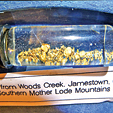All Articles
Legislative Update
September 1999 by Robert Sanregret
Summary
1. The U.S. Court of Appeals Affirms Congressional "Non-delegation Doctrine." The Court ruled that Congress may not delegate legislative power to administrative agencies.2. Submission of the 1997 Kyoto Protocol for Senate Ratification Delayed. The Global Warming Treaty is the third in a series of three treaties that would form the basis for implementation of the "Wildlands Project" in the United States.
3. Congress Has 16 Endangered Species Act Bills Before It and There are More to Come. Many ESA reform and renewal bills have been introduced and more are proposed, including the old S-1180, from the last Congress.
4. Status of Mill-Site Restriction is Still Uncertain. The House voted to approve the administration's restrictive mill site acreage policy, but the Senate has approved removing the restriction.
5. Congress Shoots Down President Clinton's "Land Legacy Initiative" But Funds the LWCF. The "Billion Dollar Land Acquisition Fund" appears dead, replaced by LWCF, under control of Congress.
Comments
1. The U.S. Court of Appeals Affirms Congressional "Non-delegation Doctrine." The administration suffered a substantial defeat in a recent Court of Appeals decision holding that it is a fundamental principle of federal law that Congress may not delegate legislative power to administrative agencies, and that the adoption of certain agency rules... "was an unconstitutional delegation of legislative power."The case involves the adoption of certain regulations of the Environmental Protection Agency (EPA) that were based on the EPA's own internal "scientific conclusions" of health claims upon which the administration's 1997 air quality regulations were based. These EPA standards for airborne particles were held by the U.S. Court of Appeals to be "arbitrary and capricious." The court held that Congress did not have the power to delegate to the EPA the legislative power to make such findings and conclusions, that the EPA ignored "sound science" when making their rules, and that the EPA ignored the devastating effects that their new rules would have on economic growth.
Chairman Boyden Gray, of the Citizens for a Sound Economy, submitted an amicus brief in this Court of Appeals case; and in commenting on the court's decision Mr. Gray stated:
"This decision has implications beyond the EPA rules. This calls into question a whole host of executive branch actions ... "
This federal Court of Appeals decision and the court's finding of an unconstitutional delegation of legislative power to the EPA is a clear victory for the proponents of tighter scrutiny of the regulatory power of federal administrative agencies.
This ruling reaffirms the Constitutional "separation of powers" doctrine by enforcing the system of checks and balances and Constitutional limits on Congressional delegation of power and authority to the administrative agencies, in this case the EPA. The function of the administrative agencies is to carry out, or "administer," the laws passed by Congress; and Congress has a public forum and accountability to their constituents, unlike the agencies.
The Feds are expected to appeal this decision to the U.S. Supreme Court. However, if the high court affirms the decision, it will even further emphasize the Constitutional message that Congress may not delegate legislative power.
2. Submission of the 1997 Kyoto Protocol for Senate Ratification Delayed. The Administration has decided to delay the submission of the Global Warming Treaty (the Kyoto Protocol) until the year 2000, or even 2001, when the President feels that the chances of Senate ratification might be better. This treaty is the third leg of a program of treaties leading to the implementation of a master plan, called the "Wildlands Project", embodying broad land-use controls with minimal participation of Congress. The "Wildlands Project" is a grand design to transform over half of the land area of the United States into an immense ecological park, devoid of industry and private property.
Once a treaty is ratified (under Article II, Section 2 of the U.S. Constitution), it becomes law, and is nearly impossible to "undo." Dr. Michael S. Coffman, the executive director of Sovereignty International has written an excellent comprehensive and readable article on this subject. (If you would like a copy of Dr. Coffman's article, with maps, send a stamped return envelope to me: Robert Sanregret, 17621 Irvine Blvd., Suite 100, Tustin, CA 92780).
A brief look at the background of these interrelated programs, and the three key treaties, is useful in analyzing this massive land-use control plan for the United States, and for the world:
In 1973, the first of these treaties, the World Heritage Treaty, was signed by President Nixon, ratified by the Senate, and steps were taken to establish the "Man and Biosphere (MAB) Program" and the Wildlands Project. This was the same year that the Federal Endangered Species Aet (ESA) was enacted. In 1973, Congress, the President and the public, were preoccupied with the Vietnam War and Watergate—the World Heritage Treaty and the ESA were approved relatively unnoticed.
In 1992, the Rio de Janiero Biodiversity Summit, presented the next treaty the United Nations Convention on Biological Diversity (known as the "Biodiversity Treaty." This treaty was signed by President Clinton in 1993. In 1994, the President submitted the Biodiversity Treaty to the Senate for ratification; but a few days before the scheduled Senate vote several groups, led by the American Sheep Industry, held a massive grassroots citizen telephone call-in opposing the treaty and clogging Capitol Hill telephone lines. Senator Kay Bailey Hutchinson (R-TX), literally one hour before the key Senate vote on the treaty, submitted a copy of the "UN Global Biodiversity Assessment" along with maps showing the impact of the UN Wildlands Project on the United States. Treaty proponents, and the United Nations, had maintained that these materials and maps did not exist. Then Senate Majority Leader George Mitchell (D-ME) removed the Biodiversity Treaty from Senate floor consideration. It has not been resubmitted to date as President Clinton is reportedly holding it until 'the time is right.' In 1997, the Kyoto Protocol (Global Warming Treaty) was signed by President Clinton, but has yet to be submitted to the Senate for ratification. Only recently, President Clinton expressed his intention not to submit the treaty to the Senate for ratification this year, but rather to wait until chances for ratification are better. We have discussed this treaty in this column and the fact that it would severely restrict the United States and other developed countries, while providing little restriction to undeveloped countries. The treaty would have a devastating effect on the U.S. economy, including the loss of millions of jobs and over $1-trillion in economic output.
These are the three key treaties comprising the building blocks towards implementing the Wildlands Project. There have been, of course, many other activities and events bearing on the implementation of the Wildlands and related projects, on the issues of Executive Branch restrictions on economic growth, and on non-Congressional land-use plans and land restrictions. However, unlike 1973, Congress is now taking a much closer look at legislation, regulations and treaties related to issues ofland-use controls and national sovereignty.
Examples of today's increased Congressional concern are: The Senate's 95-0 vote in 1997 against the Global Warming Treaty in its present form and the House of Representatives' passage of the American Lands Sovereignty Protection Act (H.R.883), which would require Congressional approval of any United Nations-sponsored World Heritage Sites or Biosphere Reserves in the United States. S.510, by Senator Campbell (R-CO), is the Senate companion to H.R.883 and is currently pending in the Senate. Although the American Lands Sovereignty Protection Act has been introduced and has died without passage in the last several Congresses, growing public awareness of the situation has resulted in Congress being more attentive to the matters of land use control.
The Administration continues its efforts, however, to implement the provisions of these Treaties, and programs, by Executive Order and administrative regulation without the approval of Congress.
3. Congress Has 16 Endangered Species Act Bills Before It and There are More to Come. Many bills and proposals are swirling around Congress to renew, revise and reform the Endangered Species Act (ESA). There are already 13 ESA bills in the House and three in the Senate.
The most significant proposal, not yet a bill, emanates from Idaho Governor Dirk Kempthorne, through the Western Governor's Association (WGA). This proposal would revive his old S-1180 ESA Renewal and Reform Bill from the last Congress, when Kempthorne was a senator. Kempthorne left the Senate, and is now the Governor of Idaho.
S.1180 was, and still is, controversial. It is supported by Interior Secretary Babbitt and by the Fish and Wildlife Service (FWS), but is opposed by most environmental groups and by many landowners. Many property rights groups not only oppose S.1180, but seek repeal of the entire ESA, leaving the endangered species matters to the States.
S.1180 would renew the ESA, which has been technically expired for five years. It would retain the present listing and recovery format of the ESA, and would formalize into law some of the policies and procedures now being practiced by the FWS.
Senators Mike Enzi (R-WY) and Craig Thomas (R-WY) have sponsored S.1305 which would require minimum standards for a petition to list a species as threatened or endangered. Thomas stated that S.1305 would prevent ESA listings having "little or no scientific support."
The Senate Environment Committee has approved S.1100 that would defer final identification of "critical habitat" for about three years from the listing of a species, until the issuance of a recovery plan. The current ESA requires that critical habitat be identified immediately upon listing.
With Congress facing a rather busy several months on negotiations and compromises involving taxation, budget and appropriations bills, as well as campaigning for reelection, it is doubtful that there will be much time left this year for discussions of existing and new ESA renewal and reform bills.
4. Status of Mill-Site Restriction is Still Uncertain. By the large margin of 273-151 in July, the House approved the mill-site acreage restriction for hard-rock mining claims. The Senate Appropriations Committee had previously voted to eliminate the mill-site restriction in a rider to a committee-approved version S.1292, a Fiscal Year 2000 Appropriations Bill.
Senator Patty Murray (D-WA) has stated that she will offer an amendment to remove the mill-site provision from S.1292. Murray stated that she opposes riders attached to appropriations bills, because they "...do not address all of the serious problems with the 1872 Mining Law."
The restrictive mill-site policy was created by Interior Solicitor John Leshy in a November 7, 1997 "opinion" holding that a lode mining claimant may use no more than one 5-acre mill site for each lode claim. Mining officials claim this policy would bar the development of a majority of existing mining operations on public land because of a lack of space to store mine tailings and waste.
A compromise has been discussed that would exempt existing permitted operations from the mill site restriction, but would not effect new operations or expansion of an existing operation: The Senate Committee approved a rider by Senator Larry Craig (R-ID) that would eliminate any and all restraints on the amount of mill-site acreage. This amendment has substantial support, including that of Senator Richard Bryan (D-NY) and Harry Reid (D-NV).
Rep. Nick Joe Rahall (D-WV), well-known as being anti-mining, offered an amendment that would prohibit any money being spent to block the implementation of the restrictive Leshy mill-site policy. Rep. Barbara Cubin (R- WY), Chair of the House Energy and Mineral Resources Subcommittee, took strong issue with Rahall by pointing out that no such restriction exists in the Mining Law, and that "no one has ever made that ruling except the current Solicitor." Cubin went on to say that "this millsite limitation is not in the Mining Law, and the Solicitor knows it!"
The battle lines are drawn on the restrictive mill-site policy, and may be determined this year by one of the dozens of riders to a Fiscal Year 2000 appropriations bill.
5. Congress Shoots Down President Clinton's "Land Legacy Initiative" But Funds the LWCF. It is too early to accurately predict the final outcome of the controversial "Billion Dollar Land Acquisition Fund" bills, but it appears that the President's "Land Legacy Initiative" is dead, and that the House has revived the Land and Water Conservation Fund (LWCF), which is directly under the control of Congress.
One major criticism of the massive Land Acquisition Programs is that they are off-budget, meaning that there would be little or no Congressional oversight or monitoring of these funds if this massive spending program were to be enacted. Although many in Congress oppose LWCF spending, at least LWCF is under the control of Congress through the powerful Interior Appropriations Subcommittee. Chairman Ralph Regula (R-OH) would be quite happy to have this important power and responsibility restored to "his" House Interior Appropriations Subcommittee.
Conclusion
Congress has "dissed" several of the administration's pet projects, including the barring of funding for the American Heritage Rivers Initiative (AHR!) and Clinton's "Land Legacy Initiative. "So far there have been no direct attacks on the Mining Law, but Interior Secretary Babbitt and his Solicitor, John Leshy, are continuing their indirect attacks on mining and on RS-2477 roads through regulations, "policies," "opinions," and statutory interpretations—circumventing Congress.
Despite strong support by a coalition of Western conservatives and liberals, an amendment to H.R. 2466 failed, which would have removed the Forest Service "Fee Demo Program" (the $5/day Parking Fee). There is unusually strong administration support for this controversial combination revenue/land control/pork program, and for making the Fee Demo Program permanent for the four agencies involved—possibly even adding the Corps of Engineers and the Bureau of Reclamation. We certainly have not seen the end to the $5/day Parking Fee controversy.
This will be an important and active several months in Congress. The newspaper headlines will be discussing taxes, the budget, Y2K and, of course, the upcoming 2000 elections. Your Senators and Representatives should be kept aware of your views on pending legislation, on regulatory activity in the agencies, and on other important matters that rarely make the headlines.
Direct your letters, calls and faxes to both the local and Washington offices of your members of Congress.
Their addresses and telephone numbers are as follows:
Senator (fill in the blank)
U.S. Senate
Washington, D.C. 20510
(202) 224-3121
Representative (fill in the blank)
U.S. House of Representatives
Washington, D.C. 20515
(202) 224-3121

Miners Welcome Comments by Alaska Official
The head of Alaska’s Department of Environmental Conservation angered environmentalists by saying more than enough acres are being managed for conservation and land set-asides aren’t necessary for environmental protection.
Jamestown and Our Mother Lode Gold Rush Adventures
 There are many other locations in the area where gold has been found, but Woods Creek is the most famous of the creeks and gulches in the area where the 49ers searched for that elusive yellow metal.
There are many other locations in the area where gold has been found, but Woods Creek is the most famous of the creeks and gulches in the area where the 49ers searched for that elusive yellow metal.
A Short But Productive Hunt
 The prospects I found are known to carry heavy chunks of gold, sometimes in quartz, ironstone, or many times a rusty-looking type of shale covering.
The prospects I found are known to carry heavy chunks of gold, sometimes in quartz, ironstone, or many times a rusty-looking type of shale covering.
Melman on Gold & Silver
Man O Man, if politics isn’t the strangest game! First, we had a Presidential election that wasn’t over the night it’s over, but instead dragged on for weeks on end before “Dubya” was declared the winner. Then we had the Senatorial contest in Washington that dragged on for more weeks before the Democratic candidate won that squeaker, reducing the Senate to a fifty-fifty proposition with the Republicans having a minuscule edge by virtue of the Vice President being of their party.
Melman on Gold & Silver
Well, will wonders never cease!? It appears that Fed Chairman Alan Greenspan actually smiled when giving his most recent testimony to Congress. Actually, he was so upbeat that he carried the whole stock market with him—as well as others around the world. In fact, if there was one over-riding characteristic of the past month, it was the return of optimism over the economic future.
Sydney Resource Corp. Ventures into Canada and Mexico
 The Northern Ontario city of Timmins is famous for many things including the fact that the Timmins Mining Camp has been among the most prolific gold mining areas in the world with total historic production of near seventy million ounces since...
The Northern Ontario city of Timmins is famous for many things including the fact that the Timmins Mining Camp has been among the most prolific gold mining areas in the world with total historic production of near seventy million ounces since...
Subscription Required:
The Bawl Mill
• Over the Divide
• Our Readers Say
• Feds Eye Restrictions on AZ Archaeological Sites
• IMF Reconsidering Gold Sales to Finance Debt
• Governors Focus on Aid for Laid-off Miners
• Nevada Counties, Towns Get Forest Service Grants
• Labor Dept. Approves Aid to Laid-off Nevada Miners
• Company Notes
• ISEE Celebrates 25 Years
• Picks & Pans: Basic Dry Washing Operations in Gold Placer Mining
• Washington Miner Wins Poetry Contest
• Gold Coin Sales Boosted by Low Prices
• The Klamath Mountains
• Silver Posts Best Price in 11 Years—Strong Investment Interest and Steady Demand Cited
• Platinum—Group Metals
• Historic Mining at Mount Diablo, CA
• Gold in the Drum Mountains
• Melman on Gold & Silver
• Mining Stock Quotes and Mineral & Metal Prices
• Looking Back
Free:







